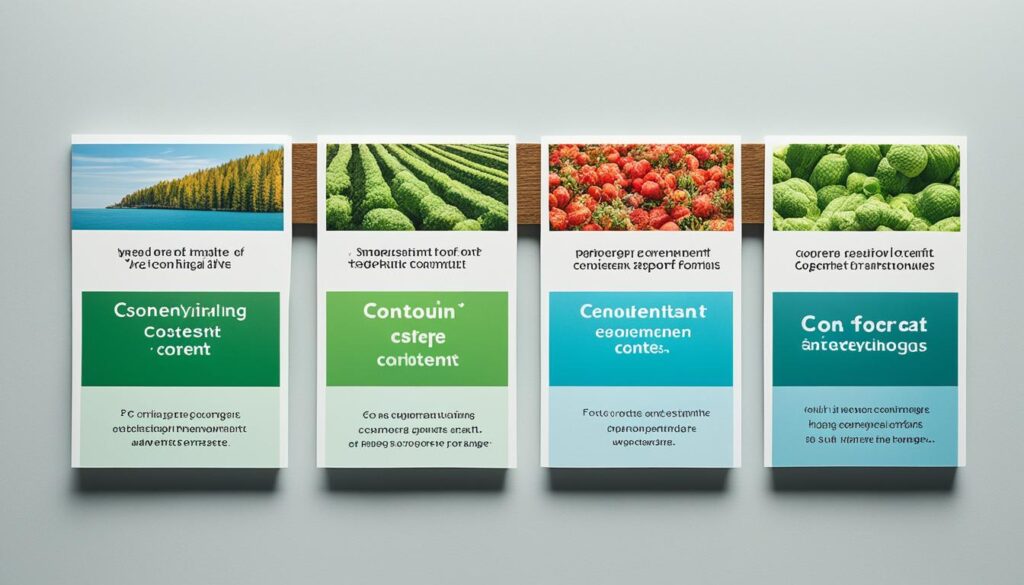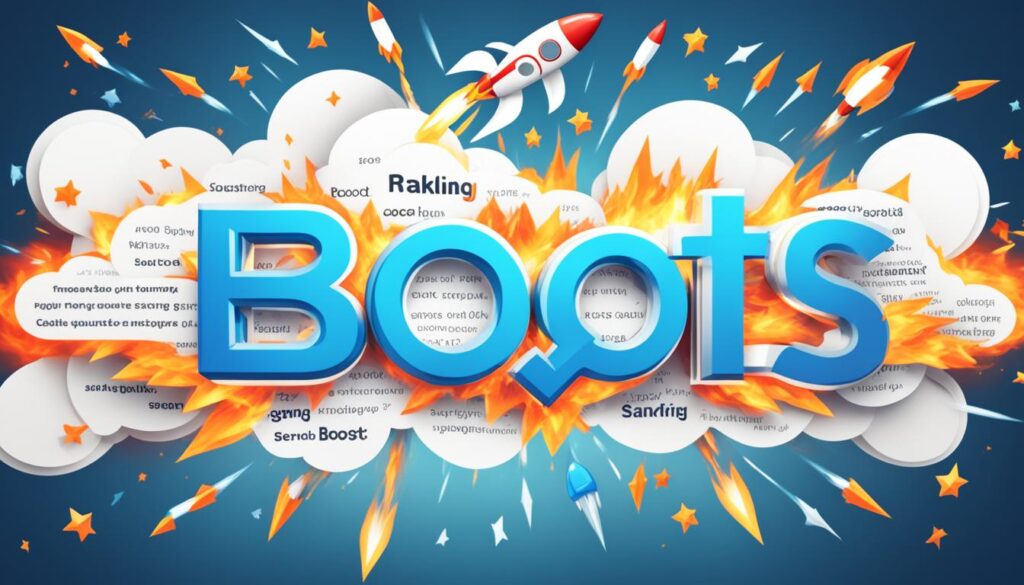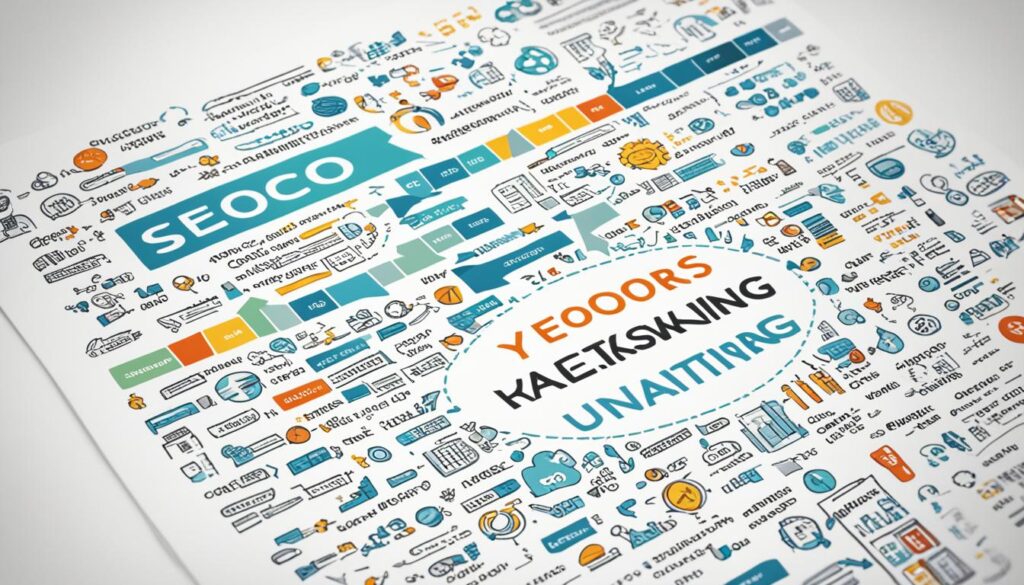Are you struggling to get your website noticed? Are your efforts to improve your search engine ranking falling short? It’s time to master the art of content optimization. By fine-tuning your website content and implementing a strategic digital content strategy, you can significantly improve your online visibility and attract more organic traffic. But how exactly do you optimize your content to achieve these results? Let us guide you through the process of content optimization and unlock the secrets to reaching a wider audience.
Key Takeaways:
- Content optimization is crucial for improving search engine rankings and driving traffic to your website.
- By optimizing your content, you can attract a larger audience and increase user engagement.
- Research, quality improvement, keyword optimization, and on-page optimization are key steps in the content optimization process.
- Long-tail keywords and internal linking play a significant role in boosting your search visibility.
- Optimizing your content for mobile devices is essential to cater to the growing number of mobile users.
What is Content Optimization?
Content optimization is a fundamental aspect of improving the performance and visibility of your web pages and blog posts. It encompasses various techniques and strategies aimed at making your content more appealing and useful to both search engines and users. By refining technical SEO performance, optimizing content copy, enhancing user experience, and improving page design, you can enhance your search visibility and increase user engagement.
Refining Technical SEO Performance: One of the key aspects of content optimization is optimizing the technical elements of your web page or blog post. This includes ensuring proper HTML structure, optimizing meta tags (such as title tags and meta descriptions) and header tags, utilizing search engine-friendly URLs, improving page load speed, and implementing mobile-responsive design.
Optimizing Content Copy: Another crucial aspect of content optimization is optimizing the actual content on your page. This involves conducting keyword research to identify relevant keywords and incorporating them strategically throughout your content. By using relevant keywords in your headings, subheadings, and body copy, you can increase your chances of ranking higher in search engine results pages (SERPs).
Enhancing User Experience: Content optimization also focuses on improving the overall user experience on your web page or blog post. This includes optimizing the layout and design of your page for easy navigation and readability, using clear and concise headings and subheadings to guide users through your content, and incorporating multimedia elements (such as images and videos) to make your content more engaging.
Improving Page Design: An aesthetically pleasing and well-designed page can significantly impact user engagement. Content optimization involves optimizing the visual aspects of your page, such as font styles, colors, and spacing, to create an appealing and user-friendly interface. By carefully designing your page, you can enhance user experience and encourage users to spend more time on your site.
Overall, content optimization plays a vital role in improving the performance and visibility of your web pages and blog posts. By implementing proven strategies and techniques, you can maximize your chances of attracting organic traffic from search engines, providing a positive user experience, and achieving your content marketing goals.
Why Are Optimizations Important?
Optimizing your content is essential for achieving success in the digital landscape. With numerous websites vying for attention, it’s crucial to make your content stand out and engage your target audience. Content optimization can significantly impact your online visibility, website performance, organic traffic, and user engagement.
“Content optimization is the key to improving your website’s visibility and attracting organic traffic. By optimizing your content, you can enhance your search engine ranking, drive more traffic to your website, and increase user engagement.”
The Importance of Online Visibility
Optimizing your content helps improve your website’s online visibility by making it more accessible to search engines. When your content is optimized with relevant keywords and structured in a way that search engines can easily understand, it has a better chance of appearing in search results and attracting organic traffic.
Increasing Website Performance
Content optimization plays a crucial role in improving your website’s performance. By optimizing your content for speed and mobile responsiveness, you can provide a seamless user experience and reduce bounce rates. This, in turn, helps improve your website’s overall performance and user satisfaction.
Driving Organic Traffic
One of the primary objectives of content optimization is to attract organic traffic to your website. By strategically incorporating relevant keywords and optimizing your content for search engines, you can increase your website’s visibility and attract targeted organic traffic, resulting in improved brand exposure and potential conversions.
Enhancing User Engagement
Optimized content is more engaging to users. When your content is well-structured, informative, and visually appealing, it captures the attention of your target audience and encourages them to stay on your website, explore more pages, and interact with your content. This increased user engagement can lead to higher conversion rates and customer loyalty.
“Content optimization is not just about improving your search engine rankings; it’s about creating high-quality, user-friendly content that resonates with your target audience and drives meaningful engagement.”
In conclusion, content optimization is vital for maximizing your online visibility, improving website performance, increasing organic traffic, and enhancing user engagement. By investing time and effort into optimizing your content, you can achieve better results and stand out in a competitive digital landscape.
How to Optimize Your Content
Optimizing your existing content is an essential step to improve its performance and achieve optimal results. Here, we will guide you through the process of content optimization, providing you with actionable strategies to enhance your content’s quality and reach.
Thorough Research
Before diving into content optimization, conduct comprehensive research to gain a deep understanding of your target audience, industry trends, and competitor strategies. By analyzing your competitors and identifying gaps in the market, you can create content that stands out and meets the needs of your audience.
Content Quality Enhancement
The quality of your content plays a crucial role in attracting and engaging your audience. Leverage your research insights to create informative and valuable content that addresses the pain points and interests of your target audience. Use clear and compelling headings to structure your content, making it easy to read and navigate.
Pro Tip: Incorporate relevant visuals and multimedia elements, such as images, videos, infographics, and charts, to enhance the visual appeal and comprehensibility of your content.
Review and Quality Assurance
A thorough review of your content is essential to ensure its accuracy, relevance, and effectiveness. Review each piece of content for any grammatical errors, factual inaccuracies, or inconsistencies. Perform quality assurance checks to guarantee a seamless user experience, including checking for broken links, formatting issues, and overall readability.

The Benefits of Content Optimization
By optimizing your content, you can significantly improve its performance and achieve the desired results. Effective content optimization enhances your search engine visibility, increases organic traffic, boosts user engagement, and ultimately drives conversions. Investing time and effort into content optimization can have a substantial impact on the success of your digital marketing efforts.
| Benefits of Content Optimization | |
|---|---|
| Improved search engine rankings | Increase in organic traffic |
| Enhanced user engagement and retention | Higher conversion rates |
| Increased brand credibility and authority | Greater website performance and visibility |
Optimizing your content is a continuous process that requires research, analysis, and ongoing improvements. By implementing these strategies, you can enhance the quality and effectiveness of your content, attracting more visitors, engaging your audience, and achieving your digital marketing goals.
Keyword Research
Keyword research plays a vital role in optimizing your content for maximum visibility and engagement. It allows us to understand the search intent of our target audience and identify relevant keywords to incorporate into our content strategy. By conducting thorough keyword research, we can uncover hidden opportunities, improve search rankings, and attract organic traffic.
When performing keyword research, we start by understanding our target audience. We delve deep into their interests, pain points, and search behaviors. This helps us gain insights into the specific keywords they use when searching for information.
Next, we use keyword research tools to discover relevant keywords with lower competition. These tools provide us with valuable data on search volume, keyword difficulty, and related terms. By focusing on long-tail keywords, we can tap into specific niches, attract targeted traffic, and increase conversion rates.
Analyzing competitor strategies and backlink profiles is another crucial aspect of keyword research. By studying our competitors, we can uncover their keyword targeting and content strategies. This helps us identify gaps in the market and gain insights into what is working well in our industry.
After gathering all the necessary data, we create a well-defined keyword strategy. This strategy guides our content creation process, helping us incorporate relevant keywords naturally into our content. By strategically placing keywords in headings, subheadings, and throughout the body, we can improve our search visibility and attract the attention of both search engines and users.

Keyword Research Process
The keyword research process involves several steps:
- Identify target audience: Understand the demographics, interests, and search behaviors of your target audience.
- Use keyword research tools: Utilize tools like Google Keyword Planner, Ahrefs, or SEMrush to discover relevant keywords with lower competition.
- Analyze competitor strategies: Study your competitors’ keyword targeting and content strategies to gain valuable insights and identify gaps in the market.
- Create a keyword strategy: Develop a well-defined keyword strategy that guides your content creation process and ensures the incorporation of relevant keywords.
- Naturally incorporate keywords: Place keywords strategically in headings, subheadings, and throughout the body of your content to improve search visibility and user engagement.
Benefits of Keyword Research
Keyword research allows us to uncover hidden opportunities, improve search rankings, and attract organic traffic.
- Understand target audience: By understanding our target audience’s search intent, we can align our content with their needs and provide valuable information.
- Improve search visibility: Incorporating relevant keywords in our content helps search engines understand the context and rank our pages higher in search results.
- Attract organic traffic: Targeting the right keywords increases the chances of attracting organic traffic and reaching the right audience.
- Increase conversion rates: Long-tail keywords, when used effectively, can drive highly targeted traffic with higher conversion rates.
By investing time and effort in keyword research, we can optimize our content to meet the needs of our target audience and achieve the desired results in terms of search visibility, organic traffic, and conversions.
| Benefits of Keyword Research | Benefits of Keyword Research |
|---|---|
| Understand target audience | Improve search visibility |
| Attract organic traffic | Increase conversion rates |
On-Page Optimization
In order to improve the visibility of your content and enhance user experience, it is essential to optimize various on-page elements. By focusing on title tags, meta descriptions, header tags, keyword density, and URL structure, you can create content that is both search engine-friendly and user-friendly.
Title Tags
When creating title tags for your web pages or blog posts, it is important to use concise and descriptive titles that include relevant keywords. Title tags are displayed as the clickable headline in search engine results, so crafting compelling titles can greatly improve your click-through rate.
Meta Descriptions
Meta descriptions are brief summaries of your web page or blog post that appear in search engine results. They provide users with a preview of what to expect when they click on your link. By crafting compelling and informative meta descriptions, you can increase the likelihood of users clicking through to your content.
Header Tags
Utilizing header tags, such as h1, h2, h3, etc., helps structure your content and improve its readability. These tags also provide search engines with a hierarchical view of your content, helping them understand the importance and relevance of different sections. By using clear and descriptive header tags, you can improve both user experience and search engine optimization.
Keyword Density
Maintaining a natural keyword density is important for on-page optimization. While it is essential to include relevant keywords in your content, it is equally important to avoid keyword stuffing, which can result in penalties from search engines. Aim for a keyword density that is natural and fits seamlessly within your content.
URL Structure
An optimized URL structure is crucial for both search engines and user experience. Use descriptive and keyword-rich URLs that provide a clear indication of the content of the page. Avoid long and complex URLs that are difficult to read and understand. A clean and intuitive URL structure can improve search engine rankings and make it easier for users to navigate your website.

| On-Page Optimization Elements | Importance |
|---|---|
| Title Tags | High |
| Meta Descriptions | Medium |
| Header Tags | High |
| Keyword Density | Medium |
| URL Structure | High |
Internal Linking
Internal linking plays a crucial role in enhancing both user experience and search engine optimization (SEO). By strategically adding internal links within your website’s content, you can help users navigate your site more efficiently, understand its structure, and discover relevant and valuable content. Not only does this improve user engagement and satisfaction, but it also assists search engines in crawling and indexing your site more effectively, which can positively impact your search rankings.
When incorporating internal links into your content, it’s important to consider the user experience. Aim to provide seamless navigation by inserting links to related content that aligns with the user’s interests and needs. By doing so, you can encourage visitors to explore more of your website and spend additional time engaging with your content.
Descriptive anchor text also plays a vital role in internal linking. Use clear and concise anchor text that accurately represents the content being linked. This not only helps users understand the destination of the link but also provides search engines with valuable context regarding the page’s content. Avoid using generic anchor text like “click here” or “learn more” and instead opt for descriptive phrases that incorporate relevant keywords.
While internal links are essential for providing a positive user experience and improving search rankings, it’s important not to overload your content with too many links. Excessive internal links can be overwhelming for users and may dilute the impact of each link. Instead, focus on strategically placing links where they provide the most value and relevance.
Benefits of Internal Linking:
- Enhances user experience by improving navigation and helping users discover relevant content
- Assists search engines in crawling and indexing your site more effectively
- Improves search rankings by providing valuable context and relevance to search engines
By implementing a thoughtful internal linking strategy, you can enhance both the user experience and search engine visibility of your website, ultimately driving more organic traffic and achieving better search rankings.
Content Length and Format
Content length and format play a significant role in determining search rankings and user engagement. When it comes to content length, long-form content tends to perform better in search results. The reason is that long-form content provides more value and offers in-depth information to readers. It also tends to attract more backlinks and social shares, contributing to improved search visibility.
However, it’s crucial to strike a balance between long-form and short-form content, as user preferences vary. Not all topics require lengthy explanations, and some users prefer concise, to-the-point information. Therefore, it’s essential to consider your target audience and the nature of your content before deciding on the ideal length.
Readability and scannability are also critical factors to consider when optimizing your content. By using headings, short paragraphs, bullet points, and other formatting techniques, you can enhance the readability of your content. This ensures that users can easily skim through the information and find what they’re looking for without feeling overwhelmed by long blocks of text.
Additionally, incorporating multimedia elements such as images, infographics, and videos can further improve user engagement. These elements make your content more visually appealing and help convey information more effectively. They break up text and provide visual cues that enhance understanding and retention of the content.
“A well-structured and visually engaging content format enhances user experience and encourages them to spend more time on your page.” – John Smith, Digital Marketing Expert
The Role of Multimedia Elements
Multimedia elements have a significant impact on user engagement and can be instrumental in making your content more memorable. Here are some key benefits of incorporating multimedia elements:
- Enhanced visual appeal: Images, videos, and infographics make your content visually appealing and captivating, increasing the likelihood of users staying on your page.
- Improved understanding: Multimedia elements can help clarify complex concepts by presenting information in a visual format that is easier to comprehend.
- Increased shareability: Content that includes multimedia elements is more likely to be shared on social media platforms, expanding its reach and driving more traffic to your site.
Incorporating multimedia elements strategically throughout your content can significantly enhance its impact and effectiveness.

In summary, optimizing content length and format is essential for improving search rankings and user engagement. While long-form content tends to perform well, it’s crucial to consider the preferences and needs of your target audience. Additionally, focus on enhancing readability and scannability through well-structured formatting and the strategic use of multimedia elements. By finding the right balance and making your content visually appealing and easily digestible, you can capture the attention of both search engines and users.
Mobile Content Optimization
With the increasing number of mobile users, optimizing your content for mobile devices is essential. Mobile content optimization improves user experience, leading to higher engagement and conversion rates. It also has a positive impact on search rankings, as mobile-optimized content ranks better in search results.
To ensure your content is optimized for mobile, there are a few key factors to consider:
- Mobile-Responsive Design: Ensure your website has a mobile-responsive design that adapts to different screen sizes. This allows users to easily access and navigate your content on any device.
- Page Load Speed: Optimize your content for faster page load speed on mobile devices. Mobile users expect fast-loading pages, and a slow website can lead to high bounce rates.
- User-Friendly Navigation: Simplify your navigation menu and ensure it is easily accessible on mobile devices. Intuitive navigation enhances the overall user experience.
By implementing mobile content optimization strategies, you can reach a wider audience and provide a seamless browsing experience across different devices.

Mobile content optimization is crucial for improving user experience, search rankings, and overall website performance.
Using Long-Tail Keywords
Long-tail keywords are a powerful tool for targeting specific niches and attracting a more focused and engaged audience. These keywords consist of three or more words and have lower competition, making it easier to rank higher in search results. By incorporating long-tail keywords into your content, you can increase your chances of reaching your target audience and driving higher conversion rates.
When it comes to long-tail keywords, specificity is key. Instead of targeting broad and highly competitive keywords, focus on identifying the specific needs, interests, and pain points of your target audience. By understanding their unique search queries and intent, you can create content that directly addresses their concerns and provides valuable solutions.
To find relevant long-tail keywords, start by conducting thorough keyword research. Use keyword research tools like Google Keyword Planner, SEMrush, or Ahrefs to identify long-tail keywords that are relevant to your niche and have search volume. Look for keywords with moderate search volume and low competition to maximize your chances of ranking higher in search results.
“By incorporating long-tail keywords into your content, you can increase your chances of reaching your target audience and driving higher conversion rates.”
When creating content around long-tail keywords, it’s important to ensure that your content provides comprehensive and valuable information that answers the specific questions or needs of your target audience. By addressing their queries in a detailed and informative manner, you can establish your expertise and build trust with your audience.
It’s crucial to incorporate long-tail keywords naturally into your content. Avoid keyword stuffing or over-optimizing your content, as this can harm your search rankings and user experience. Instead, focus on creating high-quality, engaging, and relevant content that seamlessly integrates long-tail keywords.
By strategically using long-tail keywords in your content, you can attract targeted traffic that is more likely to convert. With less competition for these keywords, you have a higher chance of ranking higher in search results and attracting users who are actively looking for the specific solutions or information you provide. This targeted traffic is more likely to engage with your content, stay longer on your website, and take desired actions such as making a purchase or filling out a contact form.
Example of Using Long-Tail Keywords:
Let’s say you own a fitness blog and want to attract an audience interested in weight loss tips for busy moms. Instead of targeting a highly competitive keyword like “weight loss tips,” you can optimize your content for long-tail keywords like “weight loss tips for busy moms” or “quick and effective weight loss tips for moms with hectic schedules.” By creating content tailored to these specific long-tail keywords, you can attract a targeted audience of busy moms looking for practical and time-efficient weight loss strategies.
Benefits of Using Long-Tail Keywords:
- Target specific niches and audiences
- Lower competition for higher search rankings
- Higher conversion rates due to targeted traffic
- Attract engaged and interested users
- Establish expertise and build trust with your audience
Incorporating long-tail keywords into your content strategy can significantly improve your SEO performance, drive targeted traffic, and help you achieve your business goals. By understanding the unique needs and interests of your target audience and creating content that directly addresses them, you can position yourself as a valuable resource and effectively engage your audience.
Importance of Internal Linking
Internal linking plays a crucial role in enhancing user navigation, improving site structure, and optimizing search engine crawling and indexing. By strategically adding internal links to your content, you can enhance both the user experience and search engine visibility of your website.
When users visit your website, internal links guide them to related and relevant content, helping them discover more information and navigate your site efficiently. This improves user satisfaction and encourages them to spend more time on your website, increasing the chances of conversions and engagement.
Furthermore, internal linking helps search engines understand the hierarchy and structure of your website. By connecting different pages and sections of your site, you provide search engine crawlers with clear pathways to navigate and index your content effectively.
Here are some best practices for internal linking:
- Add internal links strategically to relevant anchor text within your content. Using descriptive anchor text helps both users and search engines understand the context and relevance of the linked page.
- Avoid overloading your content with excessive internal links, as it can confuse users and dilute the value of each link. Be selective and prioritize quality links that provide the most value to your users.
- Ensure your internal links are working correctly and point to the intended pages. Broken or incorrect links can frustrate users and negatively impact your website’s credibility.
By implementing a well-structured internal linking strategy, you can enhance user experience, improve site navigation, and increase the visibility of your website in search engine results. Keep in mind the importance of user navigation, site structure, search engine crawling, and indexing while optimizing your internal links to achieve optimal results.
| Best Practices | Benefits |
|---|---|
| Add internal links to relevant anchor text | Improved user navigation and understanding of content relevance |
| Avoid excessive internal linking | Prevention of user confusion and maintenance of link quality |
| Ensure working and accurate links | Enhanced user experience and credibility of the website |
Optimizing Content Length and Format
When it comes to creating content for your website or blog, finding the right balance between content length and format is essential. The length of your content can impact its search rankings and engagement. Long-form content, with its in-depth information and comprehensive coverage, tends to perform better in search results. It provides more value to readers and has a higher chance of attracting backlinks and social shares.
However, long-form content alone is not enough. It’s equally important to focus on the readability and scannability of your content. Use clear and informative headings to guide readers through your text. Break up your paragraphs into shorter, bite-sized chunks for easier consumption. Bullet points and numbered lists can further enhance the scannability of your content, allowing readers to quickly grasp the main points.
In addition to optimizing the length and format of your written content, don’t forget to incorporate multimedia elements. Visuals, such as images, infographics, and videos, can make your content more engaging and memorable. They help break up the text and provide a visual representation of the information you’re sharing. Including alt text for your images can also improve accessibility and search engine optimization.
As with any optimization strategy, it’s crucial to continuously monitor and analyze the performance of your content. Keep an eye on metrics such as page views, time on page, and bounce rate to assess how well your content is resonating with your audience. If necessary, make adjustments to your content length, format, and multimedia elements to better meet the needs and preferences of your readers.






